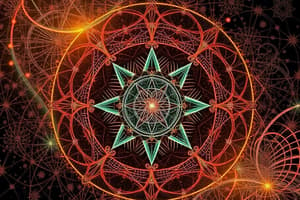Podcast
Questions and Answers
Rutherford's model of the atom successfully explained the stability of atoms.
Rutherford's model of the atom successfully explained the stability of atoms.
False (B)
Which of the following discoveries did Bohr use to develop his model of the atom?
Which of the following discoveries did Bohr use to develop his model of the atom?
- Gravity
- Radioactivity
- Electromagnetism
- Photoelectric effect (correct)
What is the primary reason why Rutherford's model of the atom was considered flawed?
What is the primary reason why Rutherford's model of the atom was considered flawed?
Rutherford's model predicted that electrons would spiral into the nucleus, causing the atom to collapse, which contradicts the observed stability of atoms.
The unique set of colors emitted by different elements when stimulated is known as ______ spectrum.
The unique set of colors emitted by different elements when stimulated is known as ______ spectrum.
Match the following atomic models with their key features:
Match the following atomic models with their key features:
Which of these colors are observed in the line spectrum of hydrogen gas?
Which of these colors are observed in the line spectrum of hydrogen gas?
Bohr's model of the atom is also known as the 'planetary model'.
Bohr's model of the atom is also known as the 'planetary model'.
What type of spectrum is produced when excited atoms return to a lower energy state from a higher energy state?
What type of spectrum is produced when excited atoms return to a lower energy state from a higher energy state?
The analysis of spectra to determine the properties of their source is called ______.
The analysis of spectra to determine the properties of their source is called ______.
Match the following types of spectra with their descriptions:
Match the following types of spectra with their descriptions:
What happens to an electron when it loses energy?
What happens to an electron when it loses energy?
Bohr's model successfully explained the line spectra of all atoms.
Bohr's model successfully explained the line spectra of all atoms.
What is the primary reason why Bohr's model is considered historically significant?
What is the primary reason why Bohr's model is considered historically significant?
The colors of light emitted by excited hydrogen atoms correspond to the _______ changes that electrons experience as they move between energy levels.
The colors of light emitted by excited hydrogen atoms correspond to the _______ changes that electrons experience as they move between energy levels.
Match the following terms with their corresponding descriptions:
Match the following terms with their corresponding descriptions:
Before the discovery of the photoelectric effect, matter and energy were considered to be separate and unrelated.
Before the discovery of the photoelectric effect, matter and energy were considered to be separate and unrelated.
What is the name given to a packet of energy in Planck's Quantum Theory?
What is the name given to a packet of energy in Planck's Quantum Theory?
The ______ effect is a phenomenon where electrons are emitted from a metal surface when it is exposed to light.
The ______ effect is a phenomenon where electrons are emitted from a metal surface when it is exposed to light.
Explain how the photoelectric effect supports the concept of quantization of energy.
Explain how the photoelectric effect supports the concept of quantization of energy.
Match the following concepts to their corresponding descriptions:
Match the following concepts to their corresponding descriptions:
Which of the following analogies accurately illustrates the concept of quantization of energy?
Which of the following analogies accurately illustrates the concept of quantization of energy?
The photoelectric effect can be explained by applying the concept of photons colliding with electrons at the metal surface, leading to their ejection.
The photoelectric effect can be explained by applying the concept of photons colliding with electrons at the metal surface, leading to their ejection.
What key discovery led to the change in the understanding of matter and energy at the end of the 19th century?
What key discovery led to the change in the understanding of matter and energy at the end of the 19th century?
Flashcards
Limitation of Rutherford Model
Limitation of Rutherford Model
The model could not explain atomic stability or electron behavior.
Bohr's Two Discoveries
Bohr's Two Discoveries
Bohr used the photoelectric effect and quantum theory to develop his model.
Bohr's Atomic Model
Bohr's Atomic Model
Suggests electrons orbit the nucleus in fixed paths without spiraling in.
Hydrogen Line Spectrum
Hydrogen Line Spectrum
Signup and view all the flashcards
Success and Failure of Bohr's Model
Success and Failure of Bohr's Model
Signup and view all the flashcards
Electromagnetic Radiation
Electromagnetic Radiation
Signup and view all the flashcards
Photoelectric Effect
Photoelectric Effect
Signup and view all the flashcards
Planck's Quantum Theory
Planck's Quantum Theory
Signup and view all the flashcards
Quantum of Energy
Quantum of Energy
Signup and view all the flashcards
Photon
Photon
Signup and view all the flashcards
Quantization of Energy
Quantization of Energy
Signup and view all the flashcards
Continuous Energy
Continuous Energy
Signup and view all the flashcards
Analogies for Quantization
Analogies for Quantization
Signup and view all the flashcards
Quantized Energy
Quantized Energy
Signup and view all the flashcards
Bohr's Model of the Atom
Bohr's Model of the Atom
Signup and view all the flashcards
Emission Spectrum
Emission Spectrum
Signup and view all the flashcards
Line Spectrum
Line Spectrum
Signup and view all the flashcards
Continuous Spectrum
Continuous Spectrum
Signup and view all the flashcards
Electron Transition
Electron Transition
Signup and view all the flashcards
Spectroscopy
Spectroscopy
Signup and view all the flashcards
Bohr's Postulates
Bohr's Postulates
Signup and view all the flashcards
Energy Gain in Electrons
Energy Gain in Electrons
Signup and view all the flashcards
Energy Loss in Electrons
Energy Loss in Electrons
Signup and view all the flashcards
Bohr's Hydrogen Spectrum
Bohr's Hydrogen Spectrum
Signup and view all the flashcards
Bohr Model Importance
Bohr Model Importance
Signup and view all the flashcards
Drawbacks of Bohr's Model
Drawbacks of Bohr's Model
Signup and view all the flashcards
Study Notes
Bohr's Model of the Atom
- Bohr's model depicts electrons orbiting the nucleus in specific energy levels.
- Electrons can only exist in certain allowed orbits, each with a specific energy.
- Electrons do not lose energy while in these allowed orbits.
- Energy of an electron increases with increasing distance from the nucleus.
- Electrons can jump between energy levels, absorbing or emitting energy in the process.
- This energy transfer corresponds to specific wavelengths of light (like the colours in a line spectrum).
- The line spectrum of hydrogen supports the idea of quantized energy levels.
- Bohr used the line spectrum of hydrogen to develop a quantum model of the atom.
- This model was a significant step toward understanding atomic structure.
Limitations of Rutherford's Model
- Rutherford's model suggested electrons orbiting the nucleus would lose energy and spiral into the nucleus.
- This model couldn't explain why atoms remain stable.
Bohr's Experimental Work
- Bohr experimented with applying electricity and thermal energy to hydrogen gas.
- He observed a line spectrum, a spectrum consisting of only certain colours.
Quantum Theory
- Energy released or absorbed is always in discrete (separate and distinct) quantities of energy.
- Energy released or absorbed is not a continuous stream.
- The energy emitted by a heated solid is quantized.
Photoelectric Effect
- Electrons are emitted from a metal surface when it is exposed to light.
Nature of Light
- Light is a form of energy called electromagnetic radiation.
- Electromagnetic radiation is produced by oscillating electric and magnetic disturbances, or by the movement of electrically charged particles travelling through a vacuum.
Light and Matter
- At the end of the 19th century, matter and energy were viewed as distinct and unrelated.
- Matter was considered particles with mass; light was considered waves with no mass.
- The photoelectric effect changed this view.
Quantization of Energy
- Quantized means energy is released or absorbed in discrete or certain amounts.
- Continuous means energy can take on all values.
Analogies for Quantization
- Canadian currency (e.g., $1, $5, etc.) is an example of quantized values.
- A person walking up stairs (only at specific heights) offers an analogy for quantized energy.
- A person walking up a ramp (at any height) offers an analogy for continuous energy.
Spectroscopy
- Spectroscopy is the analysis of spectra to determine the properties of their source using a spectrometer.
Emission Spectrum
- The spectrum produced when electromagnetic radiation emitted by atoms is passed through a spectrometer.
- Excited atoms return to a lower energy state from a higher energy state and emit light which create a unique spectrum of lines for each element.
Types of Emission Spectra
- Continuous spectrum: Contains all wavelengths.
- Emission line spectrum: Contains only certain wavelengths.
Dispersion of White Light
- When white light passes through a prism it separates into its constituent wavelengths creating a continuous spectrum.
Line Spectrum
- An emission spectrum that only contains certain wavelengths of light.
- The unique line spectrum for each element is used by astronomers to identify different elements in stars.
- It arises when excited electrons emit energy.
Bohr Model Success
- The Bohr model was historically important because it introduced the concept of the quantization of energy in atoms.
- It gave scientists insight that paved the way for later theoretical developments.
- Bohr calculated hydrogen's energy levels that closely matched experimental data from the hydrogen emission spectrum (obtained via spectroscopy).
Bohr Model Drawbacks
- Bohr wasn't able to theoretically explain why electrons in orbits don't lose energy.
- His model was only able to explain the line spectrum of hydrogen, but not the spectra of more complex atoms.
Studying That Suits You
Use AI to generate personalized quizzes and flashcards to suit your learning preferences.




